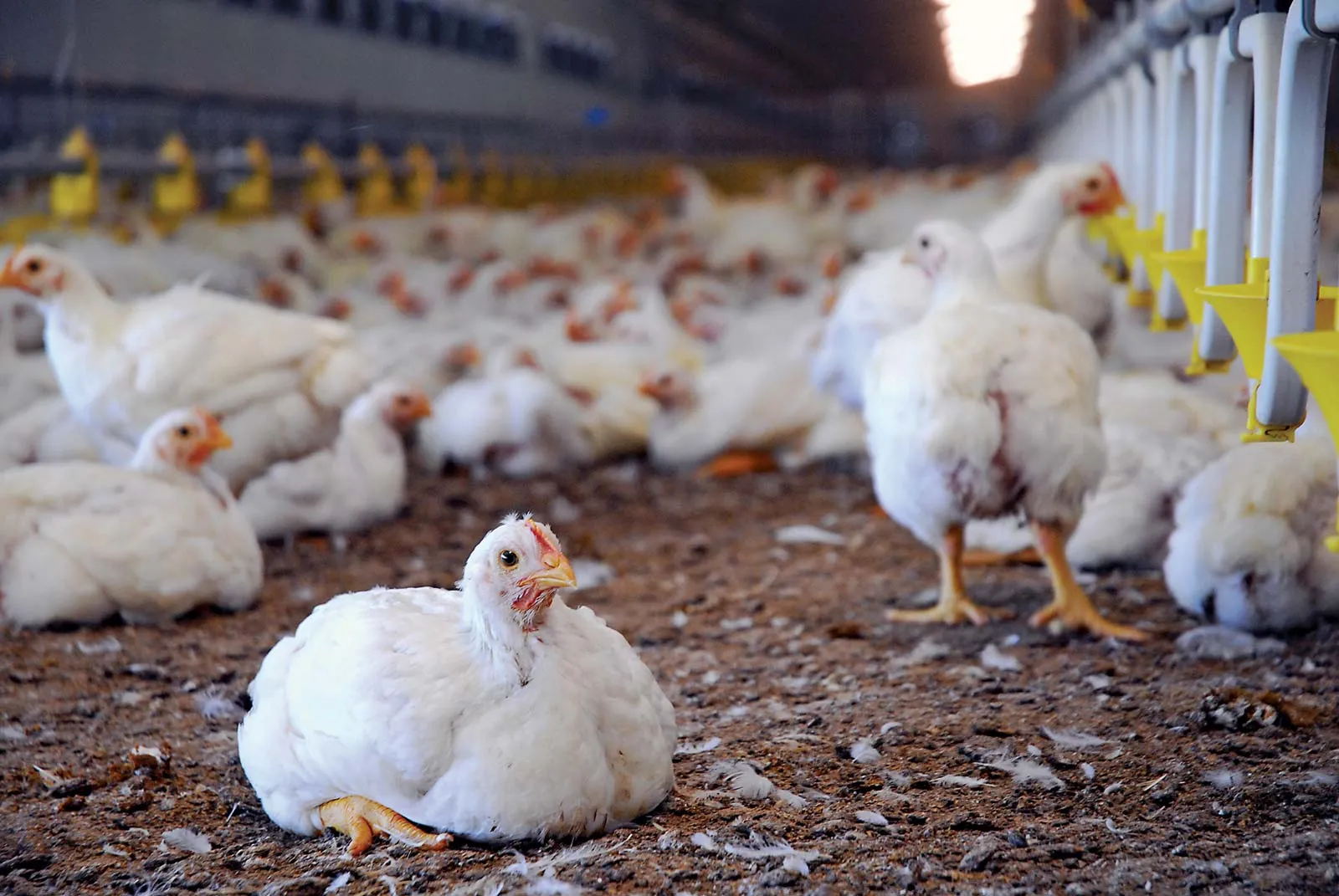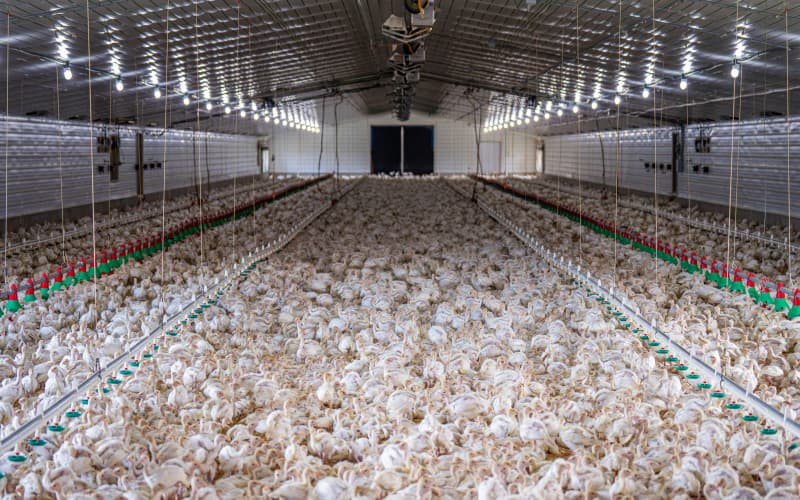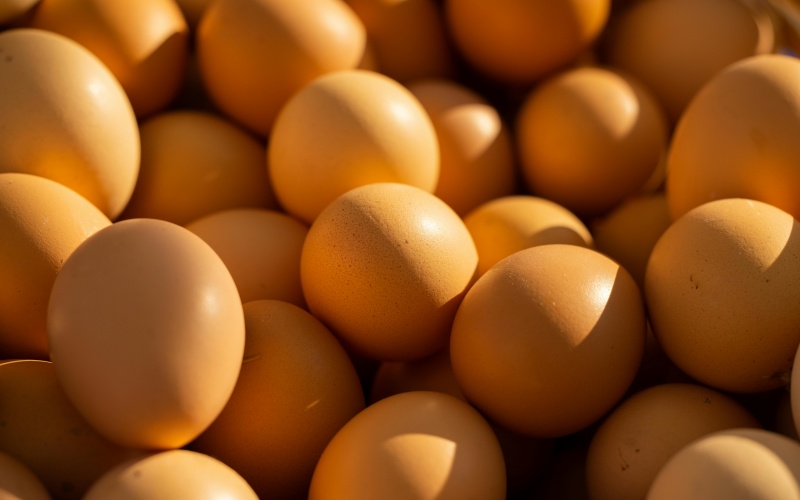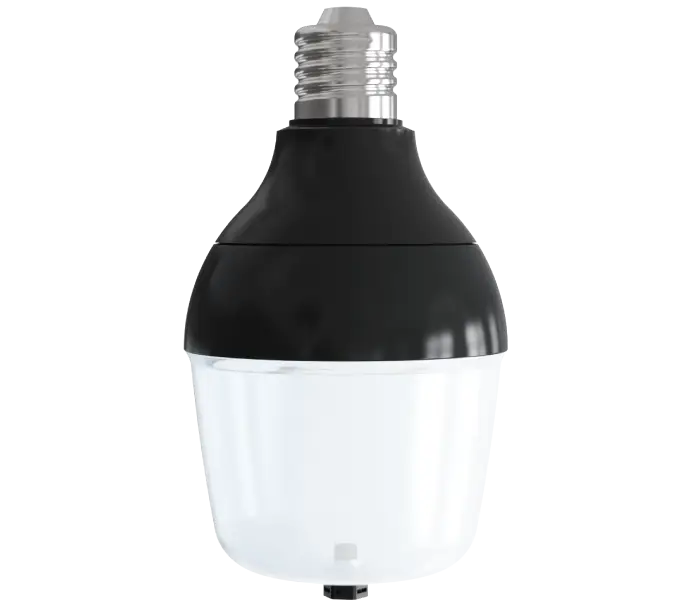家禽の照明は生産と成長にどのような影響を与えるのでしょうか?

ディレクトリ:
1. 現代の農場にとって養鶏用照明が不可欠なのはなぜですか?
1. 現代の農場にとってなぜ養鶏用照明が不可欠なのか?
養鶏場に設置されている照明は、作業員の利便性のためだと誤解している人が多いようです。しかし実際には、養鶏場の照明は鳥の生態に直接影響を与えます。
鶏などの家禽は、紫外線を含む人間よりも広い光スペクトルを感知し、その成長と繁殖は光信号と密接に結びついています。光の持続時間、強度、スペクトルは、視床下部-下垂体-性腺系を介したホルモン分泌に影響を与え、卵子の生産、成長、そして繁殖能力を制御します。
閉鎖型または大規模養鶏場では、自然光が不安定、あるいは全く届かない場合があります。適切な人工照明がないと、採卵鶏の産卵率が低下し、ブロイラーは発育にムラが生じ、種鶏は繁殖力が低下する可能性があります。そのため、効果的な照明は必須であり、生産性の向上、安定した群れの行動、そして飼料効率の向上を保証する重要な管理ツールです。

2. 家禽照明の主要パラメータの説明
鶏舎用のLED照明は、 単にランプのオンオフを切り替えるだけではありません。光周期、強度、スペクトル、リズムという4つの技術的要素が連携して、鳥の成長、行動、そして生産性に影響を与えます。
以下では、産卵鶏、ブロイラー、種鶏のさまざまなニーズに焦点を当てながら、簡単に説明します。
2.1 光周期 – 「ライトはどのくらいの時間点灯しておくべきですか?」
毎日の光への曝露時間は、鳥の成長と繁殖周期に直接影響します。養鶏業者は、鳥の種類と成長段階に応じてスケジュールを調整する必要があります。
(1)産卵鶏:
産卵期:14~16時間の連続点灯が必要です(例:16L:8D)。点灯時間が12時間未満(冬季など)になると、鶏は「産卵停止」の信号を受け取ります。
雛の飼育(0~6週):照明時間を24時間から8~10時間に徐々に減らします。これにより、鶏が早期に成熟するのを防ぎます。
(2)ブロイラー(肉用鶏):
生涯を通じて18~22時間の光を必要とします。日照時間が長いと摂食時間が長くなり、体重増加につながります。しかし、休息とストレス軽減のためには、少なくとも2~4時間の暗闇が不可欠です。
(3)ブリーダー:
Light schedules should mimic natural seasonal changes. Gradually lengthening daylength improves fertility and egg set rates.
Common mistake: Assuming “longer is always better.” For example, giving 20+ hours of light to layers actually stresses hens, reduces fertility, and lowers egg production.
2.2 Light Intensity – “How bright should it be?”
Light intensity is measured in Lux (1 Lux ≈ brightness of an overcast indoor room). Different stages and poultry types demand different levels:
(1) Brooding (0–2 weeks): 20–30 Lux. Bright light helps chicks find feed and water quickly, lowering early mortality.
(2) Laying hens (production stage): 10–20 Lux. If too strong (>30 Lux), hens become restless and develop harmful behaviors like feather pecking. Too dim (<5 Lux) reduces feed intake and egg yield.
(3) Broilers (fattening phase): 5–10 Lux. Lower brightness keeps birds calmer, reduces energy waste on movement, and supports rapid weight gain.
Practical tip: Light must be evenly distributed across the house. Avoid dark corners (<3 Lux) or hot spots. Adjust hanging height (2–3 m above ground) and lamp spacing (every 2–3 m) for balance.
2.3 Spectral Content – “Which colors matter most?”
In recent years, poultry lighting research has focused on spectrum optimization, challenging the old belief that “any white light will do.”
Traditional incandescent lamps lean toward warm light (red-dominant), while fluorescent lamps lean toward cool light (blue-dominant). However, both have limited spectral ranges and cannot precisely meet poultry needs.
In contrast, LED spectra can be customized, with each wavelength playing a different role:
l red light (620–660 nm) promotes egg production in layers and accelerates weight gain in broilers;
l blue light (450–495 nm) suppresses broiler activity but may cause stress;
l green light (520–560 nm) can help increase egg weight;
l UV-A (320–400 nm) supports vitamin D3 synthesis but requires careful control.
In practice, mixed light dominated by red wavelengths is recommended for layer houses, while broiler houses should prioritize warm red light with reduced blue content.
2.4 Light Rhythm – “Continuous or intermittent?”
Lighting schedules can be continuous or broken into cycles:
(1) Continuous lighting:
Example:
16 hours straight. Simple, but high energy consumption and greater bird fatigue.
(2) Intermittent lighting:
Example:
Layers: 2 hours light / 2 hours dark (repeating).
Broilers: 1 hour light / 3 hours dark (repeating).
Benefits of intermittent rhythm:
Saves 30–50% energy.
Gives birds more rest, lowering stress and aggression.
Research shows laying rates can improve slightly compared with continuous light.
Important note: Rhythms must remain consistent. Frequent changes disrupt circadian rhythm, stressing the flock.
In short:
When applied correctly, these parameters transform lighting from a utility into a powerful tool for poultry performance.
3. From “Traditional Lamps” to “Smart Lighting”
Lighting technology in poultry farming has changed dramatically over the past few decades. Each stage brought progress, but also limitations that explain why farms are now moving toward LED and smart systems.
Incandescent lamps were once the standard. Their spectrum is close to natural sunlight and the upfront cost is low. However, they waste most energy as heat, last only about 1,000 hours, and are unsuitable for modern large-scale houses. They remain practical only for small backyard or temporary setups.
Fluorescent lamps reduced energy use compared to incandescent and provided stronger brightness. Yet, they rely on fixed spectral output, contain mercury, and typically last around 8,000 hours. Many mid-sized farms adopted them during the transition era, but environmental concerns and limited spectral control restrict their value today.
LED lights have become the mainstream choice. They cut energy consumption by up to 70%, operate over 50,000 hours, and allow tailored spectral design for broilers, layers, or breeders. They are also mercury-free and environmentally friendly. While the initial cost is higher, the long-term performance and efficiency make LEDs the most cost-effective option for intensive poultry houses.
The latest step is smart LED systems. Beyond efficiency, they enable remote control via apps or central management software, automatic scheduling of photoperiods, and integration with climate sensors for temperature and humidity. These systems adjust lighting programs dynamically, ensuring optimal growth and reproduction with minimal manual intervention. Their upfront cost and need for professional setup are higher, but for modern farms aiming at precision management, smart lighting delivers unmatched benefits.

4. Tailored Lighting Plans for Different Poultry Types
Lighting strategies should never be “one size fits all.” Different poultry categories respond uniquely to light, so farmers must adapt programs for layers, broilers, and breeders.

(1) Laying hens (layers)
Photoperiod: 16 hours of light during production (e.g., 5:00–21:00) and 8 hours in the resting phase.
Intensity: 15 Lux evenly across the house; avoid shadowed corners below 10 Lux.
Spectrum: Red-to-blue ratio of 3:1 (around 660 nm red + 450 nm blue), with limited UV-A exposure (1–2 hours daily) to improve calcium absorption and shell strength.
Rhythm: Intermittent cycles (2 h light + 2 h dark) help conserve energy while reducing stress behaviors.
Know more details about Chicken Coop Lighting for Egg Production.
(2) Broilers (meat birds)
Photoperiod: 24 h light in the brooding phase (0–2 weeks), then 20 h light + 4 h dark from week 3 onward (e.g., 6:00–2:00).
Intensity: 25 Lux during brooding to encourage feeding and drinking; reduce to 8 Lux in the grow-out phase to limit activity and improve feed conversion.
Spectrum: Dominantly red (≈70% at 660 nm) with minimal blue (<10%) to minimize stress.
Rhythm: Continuous light early, then switch to intermittent cycles (1 h light + 3 h dark) to balance growth and rest.
(3) Breeders
Photoperiod: Seasonal simulation—gradually extend daylight hours from 12 to 16 as in spring.
Intensity: 15–20 Lux, strong enough to support activity but not excessive, which could disrupt mating.
Spectrum: Broad-spectrum lighting (red, green, blue) to mimic natural daylight and stimulate breeding behaviors.
Rhythm: Continuous light during the active phase to maintain consistent mating patterns.
When applied correctly, these tailored lighting programs improve performance, welfare, and efficiency across all poultry houses.
5. Common Problems in Poultry Lights and Solutions
Even with well-planned programs, lighting issues often appear in daily farm management. Below are the most frequent problems and actionable poultry lighting solutions.
Problem 1: Uneven light distribution
Cause: Lamps hung too high, wide spacing between fixtures, or insufficient lamp power.
Solution: Use a staggered hanging pattern instead of straight lines. Choose wide-angle LED lamps (≥120° beam angle). Add supplemental lights in corners to eliminate dark spots.
Problem 2: Sudden drop in egg production (excluding disease)
Possible causes: Shortened photoperiod due to timer failure, reduced light intensity from faulty lamps, or abrupt spectral changes after replacing bulbs.
Solution: Check timers and fixtures weekly. When replacing lights, phase in the new lamps over 1 week before a full switch. Keep photoperiod, intensity, and spectrum stable unless deliberately adjusted for growth stage.

Problem 3: Feather pecking or cannibalism in broilers
Causes: Excessive brightness (>10 Lux), too much blue light, or insufficient dark periods.
Solution: Reduce light intensity to 5–8 Lux. Shift spectrum toward red while reducing blue. Guarantee at least 4 continuous dark hours daily for rest.
Problem 4: High lighting costs
Solution: Upgrade to LED lamps to save up to 70% energy. Apply intermittent lighting cycles to reduce operating hours. Install smart controllers that adjust brightness automatically with daylight, lowering artificial light use during sunny hours.
6. Smart & Green Future of Poultry LED Lighting
The future of poultry lighting is moving beyond simple illumination. For large-scale farms, the next decade will be defined by smart integration and sustainable design.
6.1 Smart upgrades
Light–climate–feed integration: Smart systems will connect lighting with temperature, humidity, and feed intake data. For example, during heat stress, the system can automatically dim lights to reduce metabolic load.
Targeted lighting: With cameras and sensors, farms may provide individualized light programs. Weak or sick birds could receive longer photoperiods to encourage feeding, while the rest of the flock follows standard cycles.
Data-driven management: Systems will log photoperiods, intensity, and production metrics like egg count or weight gain. AI analysis will then suggest or automatically apply optimized lighting schedules tailored to each flock’s performance.
6.2 Green development
Energy efficiency: Research is pushing LED efficiency beyond 150 lumens per watt, cutting power costs further. Solar-assisted systems are likely to become viable for remote or off-grid farms.
Eco-friendly materials: Mercury-free, recyclable fixtures will become the industry standard, aligning with environmental regulations and farm sustainability goals.
Welfare-focused lighting: Welfare directives, especially in Europe, are driving adoption of sunrise–sunset simulation instead of abrupt on/off cycles. Such gradual transitions reduce stress and improve overall flock health.
As technology advances, poultry LED lighting will no longer be just about visibility—it will become a central tool for precision farming, sustainability, and animal welfare.
7. Conclusion: Poultry Lights as a High-Return Investment
For farmers, poultry lighting is not a background detail—it is a direct driver of production, welfare, and profitability. The right program can improve egg yield, shorten growth cycles, and reduce stress, while poor lighting undermines all of these.
Traditional lamps may seem affordable, but their high energy use, short lifespan, and limited control make them costly over time. By contrast, poultry LED lighting offers precise spectrum tuning, stable intensity, and smart automation that align with modern farm needs. It reduces electricity bills, lowers maintenance, and creates healthier conditions for layers, broilers, and breeders alike.
The path forward is clear: adopting poultry LED lighting is not just an upgrade—it is an investment in long-term performance, sustainability, and competitiveness. For farms aiming to maximize efficiency and prepare for future demands, switching to LED is the most practical and profitable decision today.
Related Product


8. FAQs
Q1: Which light is better for broilers?
A:ブロイラーには白色光(フルスペクトルLED)が最適です。赤色光と比較して、飼料摂取量、筋肉の成長、体重増加が8~10%向上します。また、白色光は飼料要求率(FCR)の安定化にも役立ちます(赤色光ではFCRが1.8であるのに対し、白色光では1.6)。
Q2: 赤い光が小さい卵を生み出すのはなぜですか?
A:赤色光はオキシトシンの放出を早期に引き起こし、卵黄の産卵期間を短縮させる可能性があります。これにより、30週以降は卵重が減少します。カルシウム代謝と卵殻の質を向上させるために、営巣エリアに緑色光(5ルクス)を追加することで、この現象を補うことができます。
Q3: 赤色光は産卵鶏の卵生産を改善しますか?
A:はい、赤色光(660 nm)は生殖ホルモンを刺激することで性成熟を促進し、長期使用(18~60週)で卵子数を増加させます。ただし、赤色光照射下での卵子は、白色光や緑色光照射下と比較して、特に30週以降は重量が小さくなります。
卵の品質に関しては、緑色光は赤色光よりも優れており、より厚く丈夫な卵殻を生み出します。
Q4: 赤色光は鶏の行動にどのような影響を与えますか?
A:赤色光は波長が長い(660nm)ため、概日リズムの乱れを最小限に抑え、ストレスを軽減します。受動的な行動(休息、羽繕い)を促進し、群れの攻撃性を軽減します。
対照的に、青色光は家禽の不安(例えば、あえぎ、アヒルの群れ)を増大させますが、白色光は行動の安定性を維持します。
_thumb.jpg)
